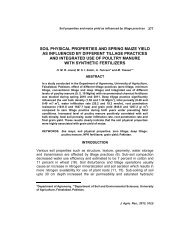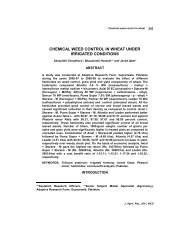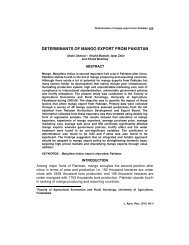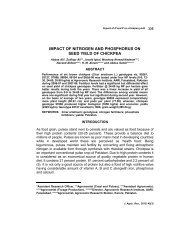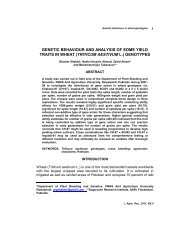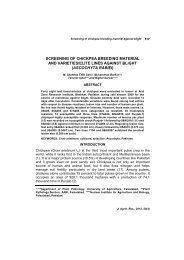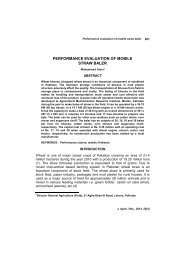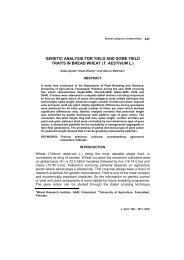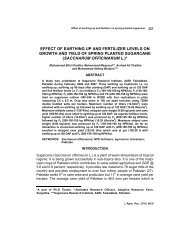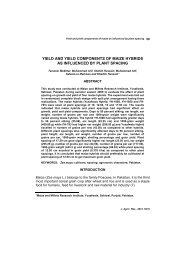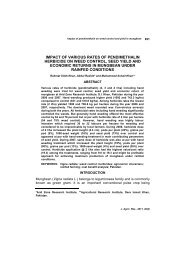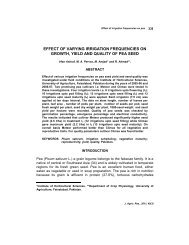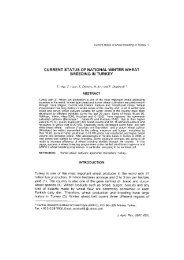effect of different dactylifera males and their whorl pollen grain on ...
effect of different dactylifera males and their whorl pollen grain on ...
effect of different dactylifera males and their whorl pollen grain on ...
Create successful ePaper yourself
Turn your PDF publications into a flip-book with our unique Google optimized e-Paper software.
512<br />
M. Iqbal et al.<br />
Table 5.<br />
Effect <str<strong>on</strong>g>of</str<strong>on</strong>g> <str<strong>on</strong>g>whorl</str<strong>on</strong>g> <str<strong>on</strong>g>pollen</str<strong>on</strong>g> <str<strong>on</strong>g>grain</str<strong>on</strong>g>s <strong>on</strong> fruit set (%) <str<strong>on</strong>g>of</str<strong>on</strong>g> cv. Dhakki.<br />
Whorl<br />
Male<br />
M 1 M 2 M 3 M 4 M 5 M 6 M 7 M 8 M 9 Mean<br />
2007<br />
W 1 79.16c 90.66b 37.50o 63.00f-h 38.50no 54.00jk 61.50gi 54.33j 64.00eg 60.29a<br />
W 2 68.33de 95.66a 43.00mn 63.00f-h 41.16m-o 58.00ij 69.50d 58.00ij 66.50df 62.57a<br />
W 3 59.16hi 94.3ab 45.16lm 64.00e-g 49.50k-i 58.50h-j 68.50de 59.66gi 59.66gi 62.05a<br />
Mean 68.88b 93.55a 41.88e 63.33c 43.05e 56.88d 66.50bc 57.33d 63.38c<br />
2008<br />
W 1 83.16 84.16 38.66 63.33 42.52 53.83 66.88 56.88 69.88 62.13ab<br />
W 2 93.50 87.16 42.00 62.50 51.83 61.00 64.33 61.88 70.88 66.16a<br />
W 3 66.66 60.50 47.16 52.66 27.50 51.50 60.00 55.88 64.88 54.07b<br />
Mean 81.11a 70.44ab 42.61e 59.50cd 40.61e 55.44d 63.72cd 58.16d 68.50bc<br />
Fruit drop percentage<br />
The significantly lowest fruit drop (34.38 <str<strong>on</strong>g>and</str<strong>on</strong>g> 33.38%) was recorded when<br />
plants were pollinated with M 2 in both years (Table 6). The results indicated<br />
that <str<strong>on</strong>g>different</str<strong>on</strong>g> <str<strong>on</strong>g>pollen</str<strong>on</strong>g> sources play an important role in reducti<strong>on</strong> <str<strong>on</strong>g>of</str<strong>on</strong>g> fruit drop.<br />
The statistically lowest fruit drop was recorded with minimum ec<strong>on</strong>omical<br />
losses when pollinati<strong>on</strong> was d<strong>on</strong>e by 2 nd <str<strong>on</strong>g>whorl</str<strong>on</strong>g> <str<strong>on</strong>g>pollen</str<strong>on</strong>g> <str<strong>on</strong>g>grain</str<strong>on</strong>g> in both years. The<br />
lowest fruit drop <str<strong>on</strong>g>of</str<strong>on</strong>g> 30.00 <str<strong>on</strong>g>and</str<strong>on</strong>g> 29.16 percent was noted when W 2 was<br />
pollinated with M 2 in both years. These results c<strong>on</strong>firmed earlier findings (12,<br />
16,18), where <str<strong>on</strong>g>different</str<strong>on</strong>g> <str<strong>on</strong>g>pollen</str<strong>on</strong>g> sources had significant <str<strong>on</strong>g>effect</str<strong>on</strong>g> <strong>on</strong> fruit drop.<br />
Table 6. Effect <str<strong>on</strong>g>of</str<strong>on</strong>g> <str<strong>on</strong>g>whorl</str<strong>on</strong>g> <str<strong>on</strong>g>pollen</str<strong>on</strong>g> <str<strong>on</strong>g>grain</str<strong>on</strong>g>s <strong>on</strong> fruit drop (%) <str<strong>on</strong>g>of</str<strong>on</strong>g> cv. Dhakki.<br />
Whorl<br />
Male<br />
M 1 M 2 M 3 M 4 M 5 M 6 M 7 M 8 M 9 Mean<br />
2007<br />
W 1 43.50 31.50 58.53 58.50 67.66 58.00 47.00 57.66 52.33 52.72a<br />
W 2 40.50 30.00 56.50 48.50 58.88 56.83 46.66 45.66 48.33 47.75a<br />
W 3 42.50 41.56 52.50 65.33 60.16 56.50 48.00 57.16 52.00 52.87a<br />
Mean 42.16d 34.38e 55.77ab 57.44ab 62.22a 57.11ab 46.55cd 53.50dc 50.88bc<br />
2008<br />
W 1 38.50 35.00 60.00 54.30 59.50 61.50 42.83 58.50 41.00 50.14<br />
W 2 37.33 29.16 56.00 55.50 53.16 53.16 40.50 49.50 39.16 45.94<br />
W 3 40.00 36.00 62.33 55.00 57.00 57.00 48.66 48.16 43.00 49.68<br />
Mean 38.61e 33.38f 59.44a 55.00b 56.55b 57.22ab 44.00d 52.05c 41.05e<br />
Fruit characteristics<br />
Fruit weight: The data (Table 7) showed that Dhakki trees pollinated with M 9<br />
male gave the significantly maximum fruit weight (18.14g) in 2007 <str<strong>on</strong>g>and</str<strong>on</strong>g> with<br />
M 5 (15.18g) in 2008. Pollinati<strong>on</strong> with <str<strong>on</strong>g>different</str<strong>on</strong>g> <str<strong>on</strong>g>whorl</str<strong>on</strong>g> <str<strong>on</strong>g>pollen</str<strong>on</strong>g> <str<strong>on</strong>g>grain</str<strong>on</strong>g>s showed<br />
n<strong>on</strong>-significant <str<strong>on</strong>g>effect</str<strong>on</strong>g> <strong>on</strong> fruit weight in 2007. The interactive <str<strong>on</strong>g>effect</str<strong>on</strong>g> <str<strong>on</strong>g>of</str<strong>on</strong>g> male x<br />
J. Agric. Res., 2011, 49(4)



